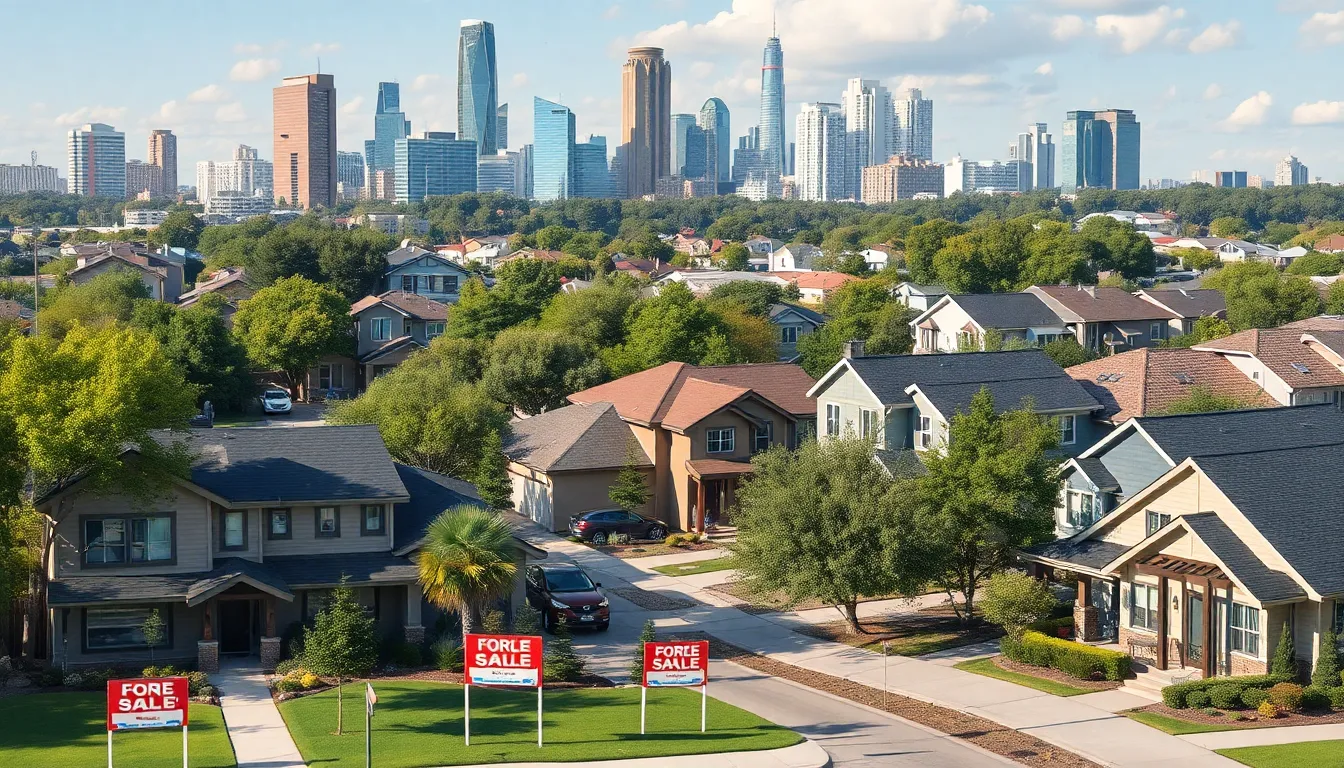Texas state housing is a hot topic, and for good reason. With its sprawling landscapes and vibrant cities, Texas offers a unique blend of charm and opportunity. Whether you’re dreaming of a cozy cottage in the Hill Country or a sleek apartment in Austin, the Lone Star State has something for everyone.
But navigating the housing market here can feel like trying to lasso a wild steer—challenging yet exhilarating. Prices are rising faster than a cowboy at a rodeo, and understanding the ins and outs of Texas real estate can save you from a financial tumble. So saddle up and get ready to explore the ins and outs of Texas housing, where the only thing bigger than the state itself is the potential for finding your perfect home.
Table of Contents
ToggleOverview Of Texas State Housing
Texas offers a diverse housing landscape reflecting its unique regional characteristics. Major cities like Austin, Houston, and Dallas showcase a blend of urban sophistication and suburban comfort. With population growth driving demand, housing prices have escalated, particularly in urban centers.
Multiple options cater to various lifestyles. Single-family homes appeal to families, while young professionals often prefer condos and apartments in vibrant neighborhoods. Each housing type meets different needs, whether it’s a growing family seeking space or an individual desiring proximity to work facilities.
Rural areas present unique opportunities for buyers seeking tranquility combined with wide-open spaces. These properties often feature larger lots and more affordable prices, making them attractive alternatives to city life. The appeal of rural housing increases as remote work becomes more prevalent.
Navigating financing options remains critical for potential buyers in Texas. Various programs are available to assist first-time homebuyers, including down payment assistance and low-interest loans. Understanding these options and conducting thorough research strengthens purchasing decisions.
Housing quality is another vital aspect of the Texas market. Developers focus on modern amenities, sustainability, and energy efficiency to attract buyers in an increasingly competitive environment. Homebuyers emphasize these features when evaluating properties, creating a market trend towards greener living spaces.
Real estate professionals cite fluctuations in housing inventory as a growing concern. The competition generated by rising demand often leads to bidding wars, particularly in sought-after neighborhoods. Comprehensive knowledge of local market trends empowers buyers to act swiftly and secure their ideal home.
Current Housing Market Trends

Texas housing experiences significant changes in pricing and availability. Various factors contribute to these shifts, particularly urbanization and demographic trends.
Price Trends
Rising prices in Texas housing markets remain a focal point. The Texas Real Estate Research Center reports an average home price increase of about 12% from the previous year. Major cities like Austin and Dallas demonstrate particularly steep escalations, reflecting strong demand and limited inventory. Buyers often find themselves in competitive scenarios, especially in neighborhoods that offer proximity to workplaces and amenities. Factors like low-interest rates and increased migration to Texas amplify these trends, pushing buyers to make quicker decisions.
Availability of Homes
Inventory levels continue to pose challenges in the Texas housing market. Many cities report a housing supply below the national average. For instance, Austin has less than a one-month supply of homes, creating competitive bidding situations. Builders face delays due to rising construction costs and supply chain issues. Additionally, the shift toward remote work generates demand for homes in suburban and rural areas, affecting availability in both sectors. Prospective buyers increasingly seek homes with extra space for offices and leisure, leading to higher interest in properties outside major urban centers. As demand remains robust, understanding availability trends becomes essential for buyers looking to navigate the Texas market successfully.
Housing Programs In Texas
Texas offers various housing programs aimed at addressing affordability and supporting first-time buyers. These programs aim to create a more inclusive housing market.
Affordable Housing Initiatives
Local governments provide affordable housing initiatives targeting low and moderate-income families. Options include rental assistance programs, subsidized housing developments, and tax credits for developers. The Texas Department of Housing and Community Affairs (TDHCA) administers these initiatives to promote accessibility and reduce displacement. Affordability varies by region, with some areas having dedicated funds to assist first-time renters and buyers. Community land trusts also emerge as a solution, providing opportunities for residents to own homes at lower costs while preserving affordability.
First-Time Homebuyer Programs
First-time homebuyers in Texas enjoy specific programs designed to facilitate their purchasing journey. Programs like the Texas Homebuyer Assistance Program offer down payment and closing cost assistance. Participants often access favorable mortgage interest rates through these programs. Households with lower incomes receive priority, ensuring equitable access to homeownership. Additionally, the TDHCA’s My First Texas Home program focuses on lower down payments for first-time buyers, making property ownership more attainable. Educational workshops also help buyers navigate the home purchasing process easily.
Challenges Facing Texas State Housing
Texas faces various housing challenges, particularly concerning affordability and the balance between urban and rural living.
Affordability Crisis
Affordability continues to be a significant concern in Texas’s housing market. The Texas Real Estate Research Center indicates an average home price increase of about 12% in the past year. As urban centers like Austin and Dallas experience rapid price escalation, many families find it difficult to secure homes within their budgets. Local governments strive to implement affordable housing initiatives aimed at low and moderate-income families. Programs from the Texas Department of Housing and Community Affairs help alleviate financial pressures through rental assistance, tax credits, and homebuyer assistance. Despite these efforts, high demand and limited inventory exacerbate the affordability crisis across the state.
Urban vs. Rural Housing Issues
Urban areas experience unique housing difficulties compared to rural regions. Urban centers contend with steep competition for limited housing stock, which leads to bidding wars and inflated prices. Cities see a surge in demand for properties as population growth stirs interest in urban living, while rural areas offer alternatives with larger lots and lower prices. However, rural housing may lack access to essential amenities and services that urban dwellers consider crucial. Accordingly, potential buyers face the challenge of balancing affordability with proximity to jobs, schools, and healthcare, making housing choices even more complex in Texas.
Navigating the Texas housing market requires careful consideration and awareness of current trends. With the ongoing demand for homes in urban and rural areas alike buyers must stay informed about pricing fluctuations and available resources. Understanding financing options and local housing programs can significantly ease the path to homeownership.
As Texas continues to grow and evolve the opportunities for diverse living arrangements remain vast. Whether seeking a cozy cottage or a modern apartment it’s essential to weigh the benefits of each option. By staying informed and proactive potential homeowners can make confident decisions in this competitive market.



